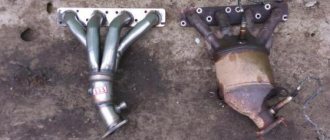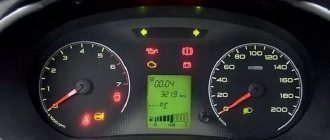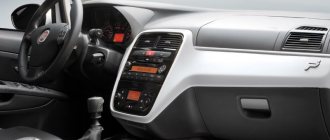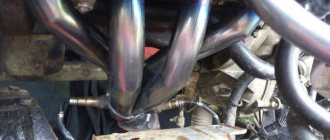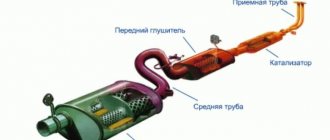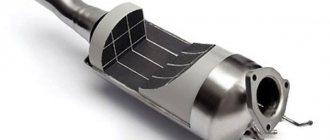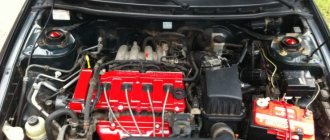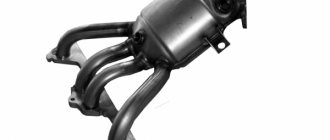The catalytic converter sooner or later makes itself felt in any car with an internal combustion engine. Then the car owner is faced with a choice: regularly buy a new part or get rid of it once and for all. The Driver News portal tells more about the catalyst and its removal using the example of LADA Granta.
LADA Granta. Photo: Driver News
The catalytic converter is knocked out, is this bad for the car?
As I wrote above, this is simply an environmental system, and if it is not there, then the car, on the contrary, will improve its characteristics (power, consumption).
To put it simply, initially the engine doesn’t care about this converter, but it creates an obstacle in the muffler, overcoming which takes part of the engine’s energy (more on this below). But why on many cars, if this unit fails (say, melted, clogged or crumbled), the CHECK ENGINE starts to light up and the car begins to behave abnormally, traction disappears, sometimes it trots a little, and simply may not start at all.
And here, friends, everything is simple. If the catalyst is melted or clogged, then the exhaust gases cannot pass through it normally, which means that some returns back into the combustion chamber and makes the newly introduced combustible mixture less efficient. The motor is choking itself.
If there is no melting, but the “CHECK” light comes on, then perhaps it has simply worn out due to high mileage. In modern cars there are so-called oxygen sensors (lambda umbrellas), one is located in front of the catalyst, the other after and detects the presence of harmful compounds; if their percentage has increased, then the second (or also called the lower “lambda”) gives a signal that the converter is not working ( or it doesn’t do its job as it should) AND IT NEEDS TO BE REPLACED. By the way, some cars may not even start (a tribute to the environment).
Thus, by knocking out or removing it, you simply free the car’s exhaust tract from the obstacle in the form of a filter and lower its environmental standards. BUT AGAIN - THIS DOES NOT AFFECT THE RESOURCE OF THE POWER UNIT IN ANY WAY!
BUT in order for your car to drive normally, you need to upgrade to a lower environmental class (usually EURO2) or install a fake one. Otherwise, the program in the ECU will not allow you to drive normally.
Fuel consumption
After you have removed this filter, many are tormented by the question of fuel consumption - will it increase or not? Of course, he will fall (so I think), no matter what anyone says. Let's think logically - if there is this filter element, it represents an obstacle that the exhaust gases need to overcome, and accordingly the engine will spend more effort to push them through (consumption increases slightly). If this element is NOT present, then the “working out” will be much easier - fuel will be saved.
Of course, you shouldn’t expect any global savings, usually it’s about 3% (maximum), but it’s worth noting that consumption will drop slightly.
No smell
VAZ 11186 engine, does the valve bend on the 8 valve grant?
Many car service centers say that you need to remove the catalysts so that there is no smell. Allegedly, you need to drive for a week, the flame arrester or spider (spacer 4-2-1) will burn out and the smell will go away. Don’t believe this, on all cars, including Vesta and Grant, the car smells strongly after removing the catalyst. Especially when you start the car after a long period of parking with a rich fuel mixture.
The smell even gets into the cabin, you have to turn on the air recirculation. There is no particular smell when moving, but there is a strong smell when standing. The car becomes like an old carburetor Zhiguli.
What did you do
I removed the resonator and welded in a normal corrugation instead of the factory one. It will be inconvenient to weld in place, so it is better to remove the resonator. Some craftsmen say that you can carefully cut it with a grinder and weld it in place. But I advise you to take it off anyway.
The mounting bolts on this machine are already different, so they came off easily. Moreover, our Lada Granta has a low mileage.
When you install a new gasket, you need to pull it through 2 times. After the first time, given that there is no flame arrester, the gasket will burn out and cut. Therefore, you need to re-stretch it. This is the only disadvantage when removing the resonator.
I decided to weld a 3-layer corrugation with internal reinforcement, size 150x45.
It is approximately the same size, but if necessary, you can trim it with a grinder. It can be seen that the layers of the mesh are made denser compared to the factory one.
Pros and cons of deletion
Features of replacing the thermostat on the Lada Granta 8-valve
I have prepared a small sign with the pros and cons of what will happen if you remove the catalyst
| MINUSES | PROS |
| Increase in harmful substances in the exhaust, decrease in the environmental component | There is no need to buy a new catalyst, because it is very expensive |
| The smell of the exhaust becomes much more toxic, sometimes this exhaust penetrates into the car (it smells unpleasant) | A small increase in power (really small in terms of error, about 3%) |
| Exhaust sound. After knocking out the catalyst honeycomb, it is advisable to install a flame arrester, otherwise there will be a ringing sound from the empty “can” (especially at high speeds) | You can install a 4-2-1 or 4-1 spider instead of an empty can, plus more power (which is said out of the blue) |
| You need to install either a fake or new firmware for EURO2 | Reduced fuel consumption (also about 3%) |
| Increasing the life of the power unit, because ceramic dust can get into the combustion chambers and wear it out prematurely |
As you can see, there are a few more advantages, the most significant is the price of this whole rework (removing it will cost several times, if not dozens of times, cheaper).
Now let's watch the video version.
In conclusion, I would like to say that removing the catalyst is NOT CORRECT AT ALL from an ECOLOGICAL point of view. After all, our planet is already polluted, and in this way you are making it even dirtier!
This is where I end, I think this material will help you make the right choice. Sincerely yours, AUTOBLOGGER.
(56 votes, average: 4.50 out of 5)
Removing the catalyst on a VAZ Granta is a responsible job that requires special knowledge and extensive experience. If you want to avoid problems in the future, contact RamFlow Exhaust Center. We carry out physical and programmatic removal of catalytic converters, installing “bleeders” and flame arresters instead. This approach to work eliminates the activation of the Check Engine light and the engine going into emergency mode.
Before knocking out, removing or cutting out the catalyst, technicians analyze on-board errors. Identifying the cause of the problem will help you avoid more serious problems in the future. The service includes:
- software shutdown of the catalyst;
- physical block removal;
- performing firmware of the electronic control unit;
- installation of a fake oxygen sensor.
If necessary, a flame arrester can be installed after removing the catalyst. Come to our auto repair shop from 9:00 to 22:00 at the address: Moscow, Beregovoi Ave., 2, building 7. We are open 7 days a week.
If the neutralizer does not function fully, the following symptoms appear:
- Sometimes (or even always) traction and throttle response disappear at high speeds. It feels as if the car lacks strength or is being held back by something.
- In the morning or when “hot,” the car starts worse. In this case, the engine has to be driven for a long time with the starter.
- Sometimes the revs disappear: the gas is squeezed to the floor, and the tachometer needle barely crawls to 2-4 thousand and freezes. There is also increased fuel consumption.
If the catalyst is completely clogged, it is easy to determine. The car takes a long time to start, and when it finally succeeds, it immediately stalls. The Check Engine light appears on the dashboard and the scanner displays an error code indicating a problem in the exhaust gas exhaust system.
A lighted “check” is the first alarm bell
It is easy to verify that the catalytic converter is not working: when you start the engine, you need to go to the exhaust pipe and see (or determine with your hand) whether gases are coming out of it or not.
Removing the Lada Granta catalytic converter
How to remove a torpedo on a grant video
Tools:
- Ratchet wrench
- Extension
- 8 mm head
- 13 mm head
- Open-end wrench 10 mm
- Open-end wrench 22 mm
- 13 mm straight box spanner
- Pliers
- Chisel
- Hammer medium
- Medium Phillips screwdriver
Parts and consumables:
- Aerosol lubricant such as WD-40 or similar
- Gasket of catalytic collector and inlet pipe
- A set of nuts securing the catalytic collector to the cylinder block
- Graphite grease
- Rags
Notes:
Carry out the work when replacing the gasket in the connection between the catalytic converter and the intake pipe with the cylinder head or when removing the cylinder head. The junction of the catalytic collector and the intake pipe with the mating plane of the cylinder head is sealed with a metal gasket. In the event that the gasket is burnt out or the nuts securing the catalytic converter and intake pipe are loose, exhaust gases can escape through this connection to the outside, which is accompanied by a characteristic sound. If tightening the nuts securing the intake pipe and catalytic collector cannot eliminate the defect, it is necessary to replace the gasket.
Carry out the work on an inspection hole or overpass. To avoid burns, it is recommended to start work after the exhaust system has cooled down.
1. Disconnect the manifold flange from the additional muffler pipe flange, as written here.
2. Remove the intake manifold/throttle assembly as described here.
3. Disconnect the oxygen concentration sensor (OC) wire connectors from the engine management system wiring harness connectors and remove these sensors as described here (control DC) and here (diagnostic DC).
4. Using a 13 mm socket, unscrew the two bolts securing the catalytic collector to the cylinder block bracket.
5. Using a 13 mm socket, unscrew the bolts securing the bracket to the cylinder block.
6. Using an 8 mm socket, unscrew the two bolts (see the first photo), and with a 10 mm wrench, unscrew the nut (see the second photo) securing the heat shield of the inner CV joint of the right wheel drive to the rear support bracket of the power unit.
7. Remove the heat shield along with the brackets.
8. Slide the collector along the studs of the cylinder head and lift it up.
9. Remove the metal gasket of the catalytic collector and inlet pipe.
10. Before installing the catalytic collector and intake pipe, clean the mating surfaces of the cylinder head, catalytic collector and intake pipe from carbon deposits with a rag and install a new gasket.
11. Before tightening new fastening nuts, apply graphite lubricant to the cylinder head studs.
12. Tighten the fastening nuts to the prescribed torque.
Notes:
Before installing the heat shield, it must be assembled with the collector brackets, but the nut securing the heat shield to the bracket must not be tightened, and the bolts connecting both brackets must not be tightened.
After installing the heat shield with brackets in its original place, you must check that all holes in the screen and brackets coincide with the holes for the fastening bolts. After the bolts are installed, it is necessary to check that the entire structure of these parts is in a free state. After this, you can gradually, step by step, evenly tighten the fastening bolts, while simultaneously checking that there is no distortion of the parts.
13. Install all removed parts in the reverse order of removal.
The article is missing:
- Photo of the instrument
- Photos of parts and consumables
https://remontglushaka.ru/yk/udalenie-katalizatora-granta.htmlhttps://nevaglush.spb.ru/raboty/p/zamenit-katalizator-na-plamegasitel-granta-lada-byt-v-ladu-so- svoim-avtomobilem.htmlhttps://www.zr.ru/content/articles/905991-kataliticheskij-nejtralizator/https://carpedia.club/Sniatie-katkollektora-Lada-Granta
Install an oxygen sensor emulator. method two, reliable
The principle of operation of the emulator is essentially the same, but it responds to requests from the engine control system more accurately and eliminates errors. True, it is a little more difficult to assemble. But for those who are comfortable with a soldering iron, there will be no problems. To assemble the device we will need:
- Variable resistance at 100 kOhm.
- Resistors 1 kOhm, 620 kOhm, 200 Ohm.
- Two 20 µF electrolytic capacitors.
- A simple printed circuit board.
Oxygen sensor emulator circuit As in the previous case, a 200 Ohm resistor is placed on pins B and D to emulate the oxygen sensor heating filament. The assembled device looks like this.
Lambda probe emulator
We place it in any suitable housing and place it under the bottom. The oxygen sensor can be unscrewed and replaced with a plug with an 18x1.5 thread. In this way, you can eliminate error P0036 on Lada Granta engines with your own hands.
Article rating:
Frame of the second dk fret grant 8 valve Link to main publication
Related publications
- Pictures for airbrushing on the hood
Self-test methods
If you know that your car has a high mileage or you are worried that the fuel you use may someday make itself felt, then it is worth checking once again whether the catalyst is clogged. It is not necessary to visit a service station. Whether the catalyst is clogged or not, you can check it yourself at home. There are several verification methods:
- The simplest method is visual inspection. It will take some effort to get the catalyst out. Because over the period of operation, bolts and nuts can rust and stick to the pipes. Let's assume that we managed to remove it. Since filters take the brunt of cleaning exhaust gases, we check them. The filter should be transparent. If you look from one end of the catalyst, you should see the sky at the other end. But sometimes the other end may be aligned with the exhaust manifold and may not be easy to view. Then we take a flashlight and shine it into the collector. If the light does not pass through, then the catalyst is clogged. Or, after removal, small pieces of metal and other rubbish fall out from inside - this is a sign that the catalytic converter is clogged.
- Checking for catalyst back pressure is the most popular method. To do this, you need to unscrew the oxygen sensor, and in its place screw in a pressure gauge through a special adapter (you can use a tube from the brake system). Having screwed in the pressure gauge, you need to start the engine and check the pressure at different speeds. If at 2500 the device shows 0.3 kgf/cm 3, then this is the norm. A maximum of 0.5 is allowed. If it is more, then this already indicates that the catalyst is clogged. This method has one drawback - unscrewing the oxygen sensor requires effort. Since the bolts become covered with rust during use, it will be difficult to unscrew them.
- Checking the temperature of the catalyst requires a special electronic pyrometer device. This is a thermometer that is designed for remote temperature measurement. So with the help of this device it is necessary to measure the temperature of the catalyst in its different parts. Before checking, you should start the engine and warm it up (driving for about 20 minutes). Using a pyrometer, we check the temperature at the weld and at the place after the “catalyst”. If the temperature in two places is the same, or the temperature at the place after the “catalyst” is less than at the weld, then this means a malfunction;
- The most effective way to determine a malfunction is to measure the pressure using a motor tester. To do this, you need to unscrew one spark plug and screw in a special pressure sensor instead. At various speeds, pressure is measured and the results are analyzed by a motor tester;
- There are other ways to check. You can check for smell without removing the catalyst. If you smell a pungent odor, that's bad.
Notice that the “CHECK ENGINE” sign lights up. This may serve as a signal that the catalyst is clogged
And finally, dear car owners, watch the video on how to check if the catalyst is clogged:
How not to “kill” a car: cut out the “cut” correctly
The complexity of this procedure directly depends on the machine. For example, BMW has metal “cats”, and when removing them you cannot do without an angle grinder and welding. Ceramic ones, like the LADA Granta, are easier to knock out.
Step-by-step instruction:
- We go to the lift.
- We dismantle part of the exhaust system with the neutralizer.
- Using a pry bar, a screwdriver and a hammer or a hammer drill with a drill with a diameter of 23 mm or more, we knock out the insides of the catalyst.
- We install a flame arrester in its body.
- We install a lambda probe decoy or flash the ECU to remove the Check Engine error.
Exhaust system with and without
decoy There are mechanical and electronic decoys, but their task is the same - to tell the “brains” that the catalyst is working and all indicators are within normal limits. Reflashing the ECU to Euro-2, roughly speaking, removes all references to the converter from the program and ignores the sensor data.
Important:
- When removing the first catalyst, there is no point in leaving the second one - the car has no use for it.
- When directly knocking out, you need to make sure that no ceramic particles remain. It is better to blow the insides of the pipe with air or use a vacuum cleaner.
- When installing a flame arrester, it is important to choose the correct size so as not to disturb the geometry of the exhaust system.
Why does the catalyst clog?
There are many reasons for this. As you and I know, this is a kind of filter that should clean exhaust gases, making them less toxic. Usually these are small ceramic honeycombs (on which a thin layer of noble metals, usually the platinum group, is applied), assembled into a special block, which are located in a special thickening of the muffler. When gases pass through, this “block” heats up to approximately 750 - 900 degrees and, under the influence of temperature, bad gas compounds are converted into safe ones.
The honeycombs are very thin (about 1 square millimeter) and they can really become clogged, this is due to systematic disruption of the engine:
- Contact with antifreeze or antifreeze. If you have a blown head gasket, or there are heat exchanger leaks, and the block itself may be damaged (in general, the coolant leaks out). Often it enters the engine cylinders and then settles with the exhaust gases on the surface of the catalyst. Not only clogging occurs, but also melting of the surface.
- Oil getting into the exhaust. This is when the power unit has an “oil leak” (the oil level is constantly falling), and the owner does nothing for a long time. Oil settling in the honeycombs does not burn, but gradually clogs them.
- Bad fuel. If you fill in some counterfeit gasoline, then during the exhaust stroke it may not yet burn out, but the burning one goes into the muffler and melts the surface of the catalyst.
- Bad firmware. If you upload untested firmware (do chip tuning), you may again get the effect of unburnt fuel, because the ignition system may be damaged or set incorrectly.
- Gas engine fuel. Or simply gas, it has its own control unit, if you configure it incorrectly, again the burning mixture will escape into the muffler and catalyst. And the exhaust from gas is much hotter than from gasoline.
Of course, there is also the option of mechanical damage, that is, hitting a rut, but this was the case on old cars when the catalyst was located at the bottom (under the car body). Now more and more manufacturers are installing it in the engine compartment, close to the exhaust manifold.
In any case, the catalyst is either clogged or melted due to fuel, gas, or poor settings. And it can no longer pass exhaust gases normally.
Removing Catalyst Grant
But high-class auto repair shops have figured out how to deceive the engine ECU - we will reflash the engine ECU, excluding the second lambda probe from the circuit. The electronics “believes” that there is no second detector in the exhaust system, so it does not expect any readings from it, and the engine operates as usual. With the “bleeder” (installed after removing the catalyst), the consumption of the fuel mixture remains the same as before with the catalytic converter.
If the catalyst is excluded from the gas exhaust system on a gasoline engine, the combustion products of the fuel mixture will act as an unextinguished flame and lead to failure of parts of the gas exhaust system (resonator, muffler). To increase the service life of the gas exhaust system, it is necessary to install a flame arrester in it. If there is such a possibility, then you can replace the catalyst with a flame arrester in the same place. If the catalyst is simply thrown out of the system, the engine ECU will display the error “insufficient catalyst efficiency p0420”. To prevent this from happening, either a decoy is installed, or the engine ECU is fully re-flashed to operate within Euro2. The more modern and complex the car, the more complex the methods for testing and monitoring the efficiency of the catalyst, so the use of decoys in terms of the significance of the result comes to naught. For example, as catalyst performance decreases, the engine ECU can change the mixture composition to reduce catalyst wear.
When removing a particulate filter on a diesel engine, you must programmatically disable the use of the particulate filter in the engine ECU - make changes to the firmware. This allows you to further significantly improve the dynamic performance of the engine. The presence in the service station of specialists with the necessary qualifications, modern equipment, as well as firmware from global manufacturers of various car brands with the necessary modifications allow us to fully remove the particulate filter on almost any diesel engine.
How to repair a muffler
If your car's muffler requires repair or complete replacement, it is not recommended to do this work yourself, since there is a high risk that you will only worsen the condition of the exhaust system, and possibly the entire vehicle as a whole. In order to prevent such a situation, contact only specialized car services. In our car service center, qualified specialists with the necessary competence in the field of working with exhaust systems will competently diagnose the exhaust system of your car, and, if necessary, repair or install a new muffler in the shortest possible time.
If you encounter any malfunction in the exhaust system and you need to diagnose it, repair it or replace the muffler, then our salon specialists will be happy to help you with this, since we carry out all types of this work!
How does a clogged catalyst affect engine performance?
As a rule, a clogged catalyst manifests itself with very noticeable symptoms, and there is no reason to worry about its condition for no apparent reason. Among the most basic there are three:
- Having reached a certain mark on the speedometer, the car cannot gain a higher speed for several minutes. However, after a few moments the car “gets a second wind” and continues driving as if nothing had happened;
- Having reached high speeds, the car begins to involuntarily gradually slow down over several minutes (despite the driver’s intervention);
- In particularly advanced cases, the car may have problems starting the engine.
All this happens due to the low throughput of the catalyst. Deterioration of cylinder ventilation leads to a decrease in performance, since the car simply cannot “gain” the required amount of air for productive work. The thrust power drops due to incomplete filling of the combustion chamber of the fuel-air mixture. Naturally, such engine malfunctions also affect fuel consumption. Operating at higher speeds leads to an increase in consumption by 1-2 liters.
Often my blog (and my channel) receives a lot of questions regarding the catalyst, and some readers still have many misconceptions in their heads. One of them (for example) is that if you remove this part of the muffler, then it will be VERY bad for the car, it will literally stand up and refuse to go! I decided to answer all the questions at once, so today we will talk: - is it worth removing it or not (what are the pros and cons of such manipulation), what will be the consumption after cutting it out, is it necessary to flash the ECU (and what are the risks), and well a few words about “deception”. In general, it will be interesting, as usual, the video version at the end...
- Why do you need a catalyst?
- The catalytic converter is knocked out, is this bad for the car?
- Firmware for EURO2 and snag – what does this mean?
- Fuel consumption
- Pros and cons of deletion
- VIDEO VERSION
At the very beginning, I would like to say that this unit is NOT SOMETHING IMPORTANT for the car, but now “a bunch of stones” will fly at me, they say, what are you saying, but what about ECOLOGY? But if we put aside all the exclamations of the “greens”, then a car without a catalyst will work BETTER, CONSUMPTION will be lower, and the POWER will increase a little.
Technology for changing the catalytic converter to the 4-2-1 insert
To work, you need to prepare a set of keys for 13, 17, 19 and 22, you also need a socket head for 13 and a screwdriver with a flat blade. Parts you should purchase are two bolts with springs, a graphite connecting ring, an extension for the sensor, and a manifold gasket. Since the spider with tubes is longer than the standard neutralizer, it would not hurt to purchase a corrugation with double or triple braiding 200 mm long.
You must first remove the negative terminal from the battery. The further process of dismantling the standard part continues according to the following diagram:
- Remove the intake module using a 13mm socket, disconnect the injector wiring harness and the fuel supply hose.
- Unscrew the nuts securing the flanges of the intake pipe and catalytic converter, and then remove the pipe flange from the converter studs.
- Disconnect the oxygen sensor connectors and disconnect the wiring harness from the heat insulation shield.
- Unscrew the two nuts securing the catalytic converter bracket and remove the clamp.
To finally replace the standard catalyst on Kalina 8 valves with a modified spider, all that remains is to slide the flange off the studs and pull the assembly down. The head gasket seating areas should be cleaned.
The flange is cut off from the old catenary collector with a grinder and welded to a section of the pipe with corrugation. A snag is screwed into the sensor hole or the ECU is subsequently reflashed. These measures will get rid of the Check-Engine, and will also be cheaper than buying a new converter.
The insert is carefully inserted from above and placed on the cylinder head studs, after which the procedure for assembling the entire exhaust system is carried out. Corrugation can be excluded from the design, but its absence will significantly affect the vibration climate of the car.
Our centers on the city map
Do you want to inexpensively but efficiently replace the muffler on your Lada Granta? “SPB Muffler” is an urgent replacement of the front, middle and rear parts of the Lada Granta muffler with a 1-year warranty. Sign up for a free diagnostic - our service stations are located in every district of St. Petersburg! The replacement cost is reasonable and the quality far outweighs the price.
How to restore the operation of the muffler if only part of the exhaust system has failed, but you don’t want to buy a completely new one because of the high price?
Replacement (repair) of the front part of the muffler
These are the exhaust pipe (“pants”), the corrugation and the catalyst. The most resistant part of the exhaust system, because less susceptible to mechanical shocks of the road surface and temperature changes.
Signs of a malfunction of the front part: mechanical destruction of the corrugation (the corrugation is also often rubbed against the bottom of the crankcase protection) and the catalyst, a burning smell in the cabin, engine compartment, loss of power, increased fuel consumption.
New Lada: Brake faults Lada Priora (VAZ 2170, 2171, 2172)
The repair consists of installing a new corrugation, replacing the catalyst and soft metal flange O-rings.
Installation (repair) of the middle part of the muffler
This is a resonator designed to pre-muffle the sounds of exhaust gases.
Signs of malfunction: characteristic rattling under the bottom, gas breakthrough, burning of welds and flanges.
The resonator is not repaired, but replaced completely, because its internal structure along with its mineral filler is destroyed. Often the resonator and the rear part of the muffler are one integral part. In this case, we carefully cut out the middle part and weld a new one in an inert gas environment, restoring the tightness.
Replacing (repairing) the rear part of the muffler
This is the visible part of the exhaust system (“can”), the main muffler with a complex internal structure. It fails most often because... susceptible to temperature changes, the effects of “evil” road chemicals in winter and mechanical destruction among those who like to “jump” along curbs.
Signs of a Lada Granta malfunction: a loud “roar”, rattling inside the “can”, destruction of the connecting seams.
Usually the part is replaced with a new one, but sometimes a patch is applied.
It’s convenient to replace a muffler with us: our service centers are located in all districts of St. Petersburg.
We make it profitable to repair or replace a muffler part. What is the price? We know our business well. We do it quickly, efficiently, and the cost is reasonable.
We are reliable: contact us once and forget for a long time. Warranty when replacing exhaust system elements with new ones is 12 months.
Quality and guarantees
All work is carried out using special tools and technologies for dismantling stuck parts. We have a large selection of original and reliable alternative muffler parts in stock. Welding is carried out in an environment of inert gases. At the finish line, check the operation and tightness of the entire exhaust system; if necessary, replace worn-out hangers, clamps, gaskets, and cushions.
The guarantee for such work is 12 months or more.
The rear part of the muffler on Lada Granta cars most often becomes unusable. If we consider the failure of exhaust system parts in chronological order, then the rear muffler burns out first, then the resonator, and lastly the exhaust manifold. It is the rear muffler that we will change in this article.
To carry out this repair we will need the following tools and accessories:
- Penetrating lubricant
- 13 ring wrench
- 13mm socket and ratchet
- Jack
Do-it-yourself catalyst removal
Motorists often ask the question: is it necessary to remove the catalyst? Some drivers believe that making a hole in the KN ceramics adds power to the engine and improves the dynamics of the car. These arguments are incorrect - only the faulty catalyst needs to be removed, if the CO level is normal, it is better not to touch the KN.
You can remove the catalyst yourself, but to complete the work you will need welding equipment and a grinder.
On many modern cars, the main catalyst is welded to the exhaust manifold and is an integral part of it. To remove ceramics from such a CN, you must:
- disconnect the exhaust pipe of the muffler;
- remove the exhaust manifold;
- use a grinder to cut the neutralizer body;
- remove all the insides from the jar;
- weld the housing, install the manifold in place.
It should be taken into account that this measure is temporary; for normal engine operation it is necessary to install a flame arrester, or even better, a new catalyst.
Increase in oil intake
There is an opinion that after removing the catalyst, engine oil consumption increases. They are mainly removed at 150-200 thousand km. At this time, there are already scuffs in the cylinders, and oil burn is inevitable in any case at this mileage. If the removal is done on a new car, there will be no oil consumption, you can check.
They also say that oil is being thrown into the corrugation and the air filter. I specially removed the corrugation and decided to take a look.
I didn't see any signs of abandonment. This myth is unfounded. The mileage is already 1000 km, and if there was something, I would see it.
Signs of a bad catalytic converter
Any mechanism or device, no matter how durable it is, will sooner or later fail, especially if it has to work in critical conditions. The catalytic converter, which is responsible for cleaning exhaust gases from pollutants, operates at fairly high temperatures. However, a damaged or clogged converter has a negative impact on vehicle performance, which a vigilant driver cannot fail to notice.
Power Loss
For a person who is not particularly familiar with the structure of a car, the most important symptom is a loss of engine power while driving up a hill. At the same time, there is a clear feeling that the engine is running under high load. Even a novice driver can recognize such a sign of a clogged catalytic converter as increased fuel consumption.
Damage due to thermal shock
Inspect the outside surface of the catalytic converter for visible damage. Discoloration and/or deformation of the neutralizer body are clear signs of thermal destruction of the substrate as a result of overheating. Such damage is most often caused by the fuel mixture supplied to the engine being too rich, resulting in unburned fuel entering the catalytic converter. This fuel burns out in the neutralizer itself, simultaneously melting its substrate, which leads to blocking the operation of the component.
Blockages prevent gases from passing through the catalytic converter, causing back pressure to build up in the exhaust system, which negatively affects engine efficiency. Thermal shock can also occur when a hot catalytic converter comes into direct contact with ice or cold water, as this can crack the internal substrate, again leading to clogging and increased temperature in the converter, ultimately reducing engine power.
An oxygen sensor is a device that helps the control unit evaluate engine performance. It is installed in the exhaust manifold and is designed to determine the composition of the fuel mixture, that is, whether it is too rich or lean. The sensor sends a corresponding signal to the control unit, after which the control unit regulates the composition of the air-fuel mixture supplied to the engine (the ideal ratio of air to gasoline is 14.7:1). A faulty oxygen sensor may send incorrect data to the control unit, resulting in damage to the catalytic converter.
Rattling sound due to mechanical damage
Sometimes rocks and debris thrown off the road can hit the catalytic converter and damage its internal components. Such damage is identified by dents on the outside of the converter. If the ceramic part of the catalytic converter is cracked or completely broken, a rattling sound will occur. Over time, this will block the catalytic converter and build up back pressure in the exhaust system.
Smell of gases
If the exhaust gases coming out of the exhaust pipe have a sulfurous odor, reminiscent of the smell of rotten eggs, this clearly indicates a clogged catalytic converter. When someone doubts that a decrease in engine power is due to a clogged converter, he only needs to sniff the exhaust gases. The cause of this problem is the improper composition of the air-fuel mixture. Unfortunately, this symptom is the last to appear. Finding a problem this late usually means the catalytic converter cannot be repaired. The car owner will most likely have to fork out money for a new converter.
Toyota Carina E
In general, it burned and stopped. I returned to the car, opened the hood, opened the distributor cap, and there was a swamp. He wiped away the moisture, dried it and finally made it to the office. Now answer the question: where do you think the fuel burned?
What if it’s the end?
Not everyone can or will want to replace a failed catalytic converter on an out-of-warranty car with an original one. Before _
rogo it. What are the options for the development of events?
- Just knock the filling out of the neutralizer. This requires reflashing the control unit so that it “turns a blind eye” to the signal from the second oxygen sensor, or installing a mechanical or electronic switch. The mechanical one is a bushing in which a piece of the catalytic converter is fixed, and the electronic one simply simulates the correct signal from the oxygen sensor.
- Knock out the filling and install a flame arrester in its place. It consists of several chambers with holes that serve to reduce the temperature and pressure of gases. This somewhat reduces noise and facilitates the operation of other elements of the exhaust system. The “brains” of the car must be deceived, as described above.
- Install a universal repair catalytic converter instead of the ceramic block. Most often on a metal rather than ceramic base. The degree of cleaning will be slightly lower, but you will not feel like “pests”.
Tell us, how did you communicate with the “monster under the bottom” - the catalytic converter: does it work, was cut out, replaced?
You can get acquainted with the “illness histories” of cars of past generations by following the link.
Why do you need to replace the catalyst on a Kalina car with an 8-valve engine: causes and consequences
- Use of fuel additives.
- Unsatisfactory fuel quality.
- Unbalanced fuel-air mixture due to a broken oxygen sensor.
- Mechanical damage to the collector.
- Incorrect ignition operation.
For the most part, replacing the catalyst on Kalina 8 valves is done as a result of using low quality fuel. Its slow combustion occurs partly in the exhaust. The detonation of gasoline destroys the ceramic structure of the honeycomb, which over time begins to crumble and clog thin passages. The engine begins to overheat and loses traction.
An obstacle to the free passage of gases contributes to an increase in their pressure. When the internal combustion engine is turned off, in any case, the valve gas distribution system remains open in one of the cylinders. The excess pressure that should have escaped into the exhaust pipe throws ceramic particles back into the combustion chamber. At the next start, the dust will mix with the oil and turn into an abrasive paste, which can lead to complete failure of the internal combustion engine.
What you need to know
Before replacing a faulty Kalina car catalyst with 8 valves, you need to decide on the vehicle’s toxicity standards - Euro 2 or higher. On VAZ models, this is not difficult to find out - in the Euro 2 system, the oxygen controller is installed before the catalytic collector. Starting from the third generation of environmental standards, the diagnostic probe is also located after the neutralizer. It signals the efficiency of the device.
Since 2008, all VAZ cars meet Euro 3 standards and have two oxygen controllers. Before getting rid of the neutralizer, you need to consider some details:
- The unit is made with the exhaust manifold as a single unit.
- All sorts of solutions that boil down to removing the insides of the catalytic collector not only lead to a deterioration in acoustic comfort. Moreover, an empty housing creates an exhaust section with a large cross-section, which will lead to resonance of the exhaust system. So everything is in favor of using insertion.
- In the case of Euro 2, when installing the spider, an oxygen sensor wire extension is required, and the resonator-manifold connection unit must also be redone.
- In the case of Euro 3, a fake is installed in place of the second controller or the program in the ECU is changed.
Part Description
A catalyst is an element of the exhaust system that reduces the concentration of harmful substances in the exhaust gases. It has a simple device . In the housing, under a heat-resistant gasket, there is a metal or ceramic structure with honeycombs coated with a catalytic layer.
This part often fails when problems occur in the power supply or ignition system. Damage is caused by the use of low-quality fuel. The following signs indicate that it is time to look for a new catalyst:
- Significant loss of power.
- Increased fuel consumption.
- The car won't start.
- The Check Engine light is on.
Summary
According to some motorists, after tuning the car becomes faster, there is no hysterical roar when the revolutions approach 5,000. The exhaust sound has also changed, it has become more pleasant. In most cases, there is a decrease in fuel consumption. The financial component is also very noticeable - installing a 4-2-1 spider costs at least half as much.
Replacing the catalyst with a flame arrester on a VAZ Granta is the most economical way to eliminate problems associated with the catalytic unit. The cost of work starts from 1490 rubles. We offer a large selection of flame arresters from trusted brands. The work is provided with an official guarantee of 1-5 years. If you are planning to replace the catalyst with a flame arrester, come to the RamFlow Exhaust Systems Center from 9:00 to 22:00. We work seven days a week.
Installing a flame arrester instead of a catalyst allows you to:
- increase engine power by increasing the throughput of the exhaust system;
- save money due to the lower cost of flame arresters;
- use fuel with a lower octane number.
Our technicians are ready to remove and programmatically disable the catalyst, select and install a flame arrester, install a fake oxygen sensor and reflash the ECU. Professional equipment and durable components are used for work.
Technology for changing the catalytic converter to the 4-2-1 insert
To work, you need to prepare a set of keys for 13, 17, 19 and 22, you also need a socket head for 13 and a screwdriver with a flat blade. Parts you should purchase are two bolts with springs, a graphite connecting ring, an extension for the sensor, and a manifold gasket. Since the spider with tubes is longer than the standard neutralizer, it would not hurt to purchase a corrugation with double or triple braiding 200 mm long.
You must first remove the negative terminal from the battery. The further process of dismantling the standard part continues according to the following diagram:
- Remove the intake module using a 13mm socket, disconnect the injector wiring harness and the fuel supply hose.
- Unscrew the nuts securing the flanges of the intake pipe and catalytic converter, and then remove the pipe flange from the converter studs.
- Disconnect the oxygen sensor connectors and disconnect the wiring harness from the heat insulation shield.
- Unscrew the two nuts securing the catalytic converter bracket and remove the clamp.
To finally replace the standard catalyst on Kalina 8 valves with a modified spider, all that remains is to slide the flange off the studs and pull the assembly down. The head gasket seating areas should be cleaned.
The flange is cut off from the old catenary collector with a grinder and welded to a section of the pipe with corrugation. A snag is screwed into the sensor hole or the ECU is subsequently reflashed. These measures will get rid of the Check-Engine, and will also be cheaper than buying a new converter.
The insert is carefully inserted from above and placed on the cylinder head studs, after which the procedure for assembling the entire exhaust system is carried out. Corrugation can be excluded from the design, but its absence will significantly affect the vibration climate of the car.
Technical features of the insert for Lada Kalina 8V
The industry offers two types of tuning inserts, the design of each of them depends on the location of the pipes. Moreover, each design is designed for a specific power unit:
- Insert 4-1 is installed on forced engines with a speed range from 5,000 to 10,000 rpm. structurally suitable only for 16-valve engines.
- The 4-2-1 insert operates over a wider range and is considered a "low-end" insert. It is possible to increase engine power by about 3-5%. This is the model most often installed on the VAZ 1118.
Since it will not be possible to install a preliminary flame arrester on this VAZ car, you will have to carefully approach the issue of choosing an insert. The installation process of the part will not take much time if you follow all the recommendations.
Approximate prices
The catalyst for the Lada Granta in Russia costs from 6,300 to 18,000 rubles . The original part can be purchased for 10,000-11,000 rubles . A non-original catalyst is sold at prices ranging from 6,300 to 18,000 rubles. Prices depending on the manufacturer are given below:
- VAZ - 10,000-11,000 rubles.
- FORTLUFT – 9,600-13,600 rubles.
- URS – from 8,900 to 18,000 rubles.
- JMJ – from 8,100 rubles.
- Bosal – about 6,300 rubles.
